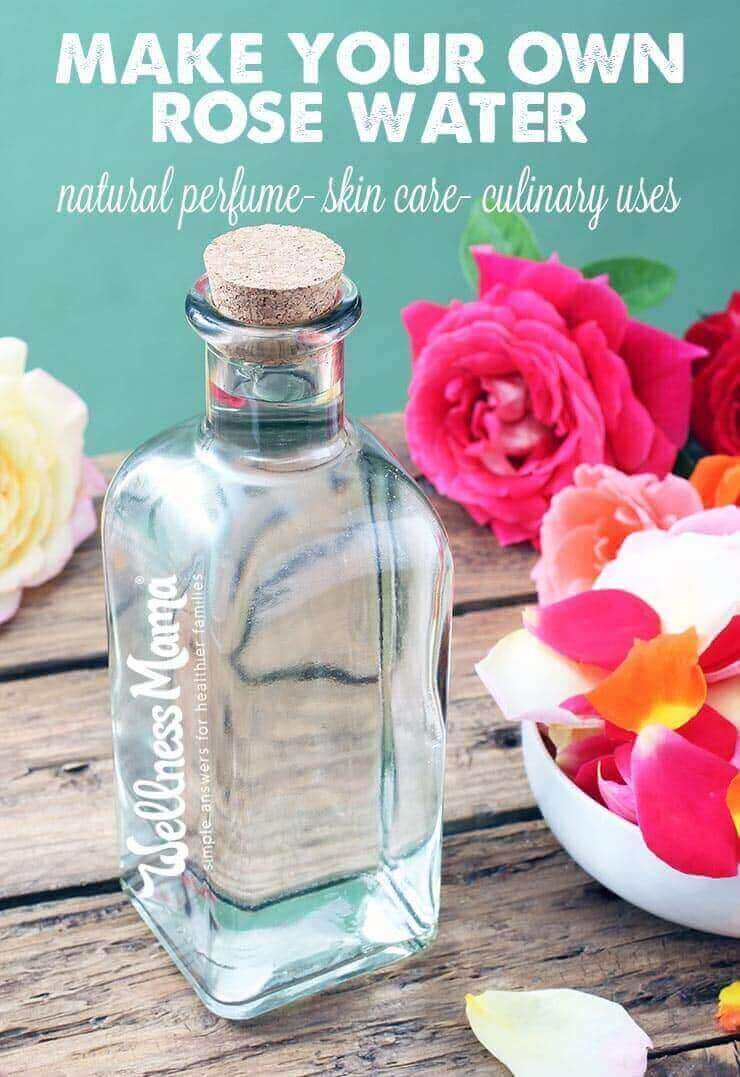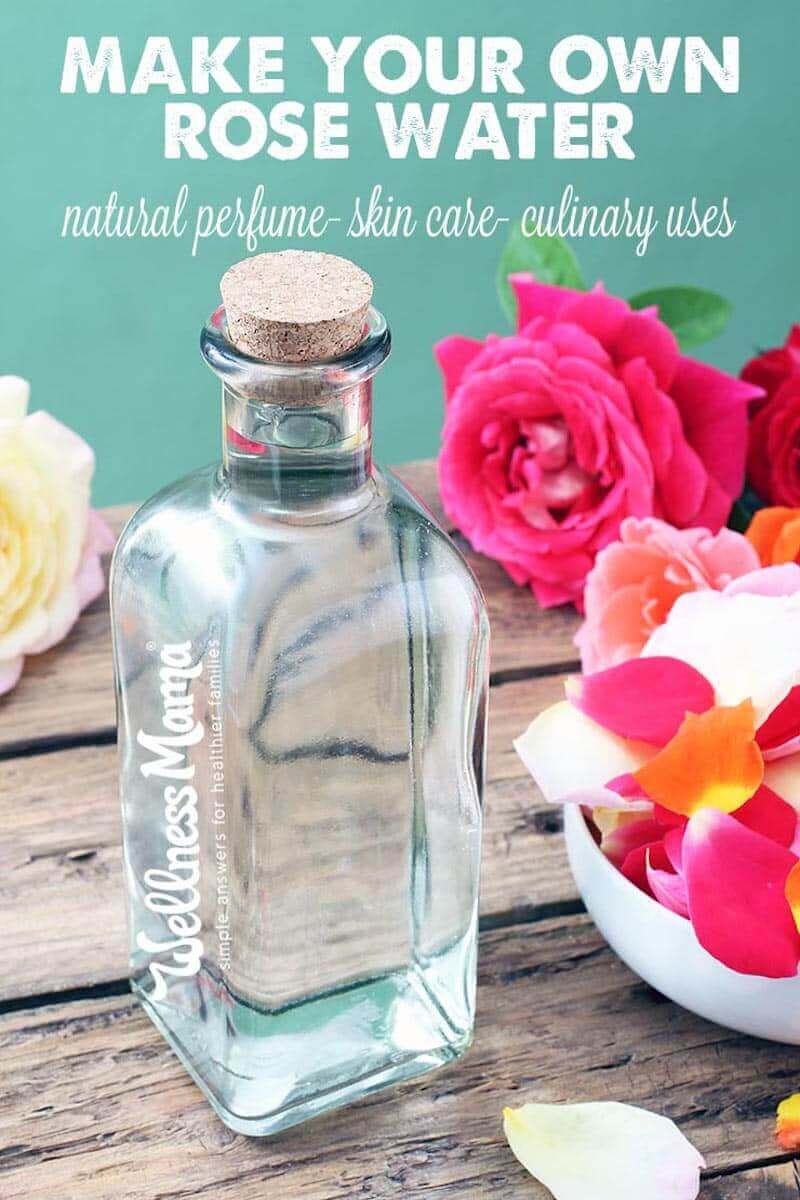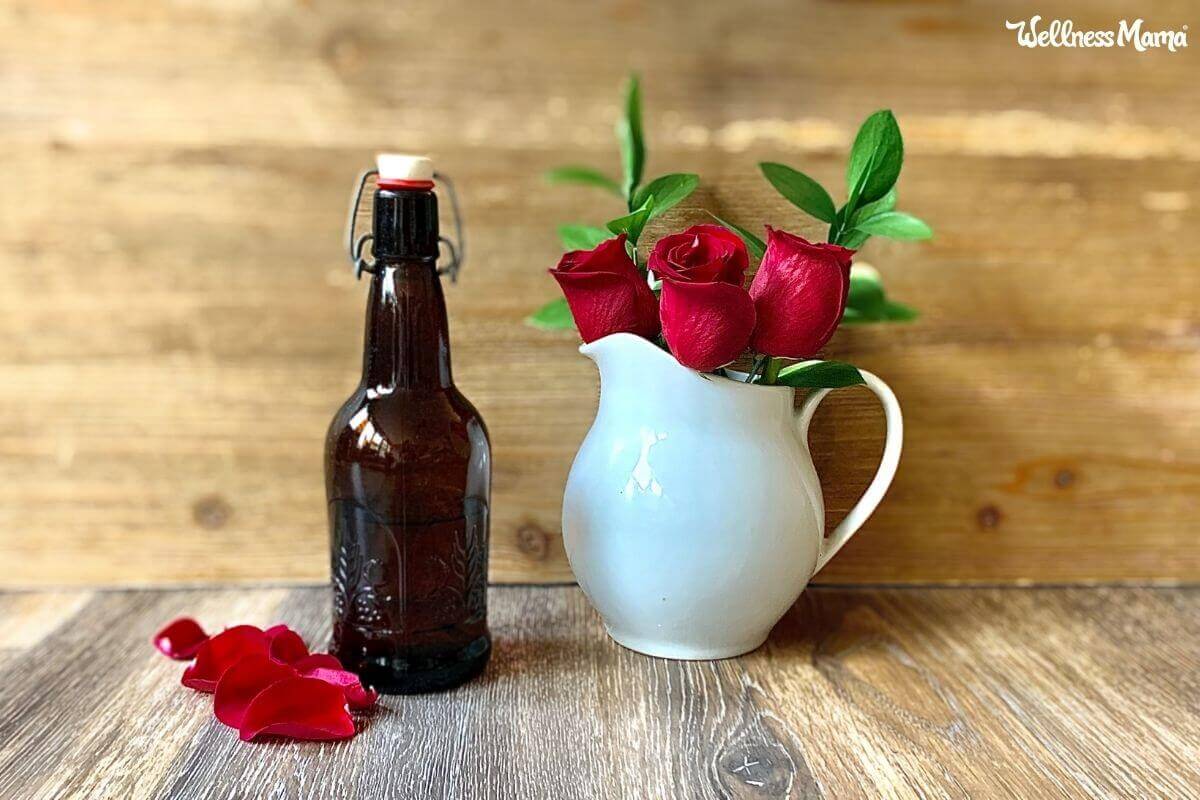Rose water is not only beautifully fragrant but extremely versatile. It has an extensive range of uses including facial toner, hair perfume, cooling mist, and linen freshener. Rose petals are edible and rosewater has a place in the culinary world as well.
I use rose water to replace some or all of the water in recipes for like soap, hair rinse, and hair detangling spray. (As a side note, it will have little impact on the final color of your soap and will definitely not turn it pink!)
How to Make Your Own Rose Water From Scratch
If you like making DIY beauty products or exotic food recipes and have access to garden-grown roses, you have to try this recipe!
There are two relatively easy ways to make rose water at home:
Simmering vs. Distilling
The easiest and quickest way is by simmering rose petals (dried or fresh) in water. The result is a fragrant, rose-colored water. This method is suited best for recipes and uses that will not sit around very long as it has a limited shelf life.
The distilling method technically makes a hydrosol. It is also quite easy to make, albeit slightly more time-consuming. A rose hydrosol is clear and much more shelf-stable.
Choosing Rose Petals
There are over a hundred different varieties of roses. If you are lucky enough to have roses growing in your garden you can use them to make rose water. If you will be picking your own roses, do so in the early morning when the blossoms are the most fragrant.
You can also purchase roses but they should be from an organic source. It is important to use pesticide-free rose petals so your finished rose water is not full of chemicals.
It’s possible to use dried petals. I like these. They are from the Damask Rose and are very fragrant, as well as edible.
Another option is to use lavender flowers. Follow the directions below for the dried petals and use the lavender water in place of the rose water in the following recipes.
Uses for Rose Water
There are so many ways to use rosewater. Here are some of my favorites.
Perfumed Sprays
One thing many people miss after they have made the switch to healthy options in beauty care is the scented aspect of commercial products. Often times those artificial fragrances are the selling point for perfumes, soaps, and shampoos, but they are also one of the more dangerous ingredients used in these products.
Rose water makes a wonderful base for making substitutes for perfumed sprays. Natural shampoo, for example, leaves your hair clean and protects the natural balance of oils in your scalp, but doesn’t leave a lasting perfumed scent. You can make a simple hair perfume to add a touch of a floral scent to your hair. You can also just dab rose water on your wrists and neck for a light hint of perfume.
Hair Perfume: Mix 1 teaspoon pure vanilla extract with essential oils in a 4 oz glass spray bottle and fill to the top with rose water. Spritz on your hair as it is drying and style as usual. This is also great for second (or third) day hair. Spritz a bit on to freshen up. Store in the refrigerator. My current favorite combination is:
- 3 drops Patchouli
- 4 drops Ylang Ylang
- 3 drops Rosemary
- 4 drops Cedarwood
- 5 drops Lavender
- 4 drops Grapefruit
- 4 drops Bergamot
Linen Freshener: Make a linen freshener by putting rosewater in a spray bottle. You can also add a couple drops of rose or lavender essential oil. Mist on your sheets before going to bed in the evening.
Skin Care
Another excellent use for rose water is in your skin care routine. Rose water helps balance the skin’s PH, reduces redness and irritation, tightens pores, and helps cool and soothe hot skin.
- Facial Toner: Store rose water in a dark colored glass bottle. Add a drop or 2 of lavender or rose essential oil and apply to your face with a cotton ball after you shower or wash your face.
- Cooling Mist: Store rose water in a dark colored bottle with a fine mist spray top. You can keep it in your purse for on-the-go use or keep it in the refrigerator for extra cooling. Mist on face to cool skin and freshen up.
- Sunburn Relief: Mix equal parts rose water and apple cider vinegar in a spray bottle and spray onto sunburned skin for relief.
Mood Improvement
Rose water is also a wonderful mood enhancer. You can mist it on yourself in the same way you use the cooling spray and breathe in the scent to lift your mood. For a calming bath, add 1-2 cups to your bath water.
Culinary Uses
- In Tea: Add rose water to taste to your herbal tea.
- Flavor Yogurt: Start with a teaspoon of rose water for 1 cup of yogurt and add more to taste.
- Lemonade: Add a splash to your lemonade for a complex flavor enhancer.
How to Make Rose Water Recipe
Materials
Simmering Method
- ¼ cup dried rose petals (or ½-¾ cup fresh)
- 1½ cups water
Distillation Method
- 1½ cups dried rose petals (or 3-5 cups fresh)
- water
- ice
Instructions
Simmering Method
- In a small saucepan, combine the rose petals and water.
- Cover and bring to a boil.
- Reduce the temperature to the lowest setting that still allows the water to simmer.
- Simmer until the color of the rose petals has faded. Mine became almost colorless. This only took about 5-10 minutes.
- Leave the lid on and cool completely.
- Pour the water and petals through a cheesecloth into a dark, clean bottle. You can use a funnel or strain into a measuring bowl with a pour spout and then pour into your dark bottle if needed.
- Store in the refrigerator for several weeks or on the counter for up to one week.
Distillation Method
- Place a clean brick (a real brick from a house) in the center of a large stock pot. I used an 8 quart stock pot and an average sized brick.
- Put a metal bowl or heat-safe glass bowl on top of the brick.
- Sprinkle the rose petals around the brick making sure not to get any into the bowl.
- Pour water into the pot over the petals until it comes almost to the top of the brick.
- Invert the lid and place it over the stock pot. This will allow the steam to collect and drip down to the center of the lid and eventually drip into the bowl.
- Put ice on the top of the lid to encourage the steam to condense and subsequently drop into the bowl. You can put it directly on the lid and suck the water off with a turkey baster as the ice melts or you can put the ice in a ziplock bag so it is easy to pull off and replace. You want to keep in as much steam as possible because the steam is actually your rosewater.
- Bring the water to a boil and then reduce to the lowest heat possible that still allows the water to simmer.
- Simmer for at least 30 minutes, replacing the ice as it melts.
- Remove the pot from heat and let it cool completely.
- Very carefully lift the lid so that none of your melted ice water falls into the pot.
- Carefully pour the rosewater that has collected in the bowl into your dark bottle.
- This will last much longer at room temperature (up to 6 months, although it doesn’t stick around that long in my house), but you could always store it in the refrigerator to be sure it keeps well.
Notes

Have you ever made rose water? What is our favorite way to use it?




Leave a Reply